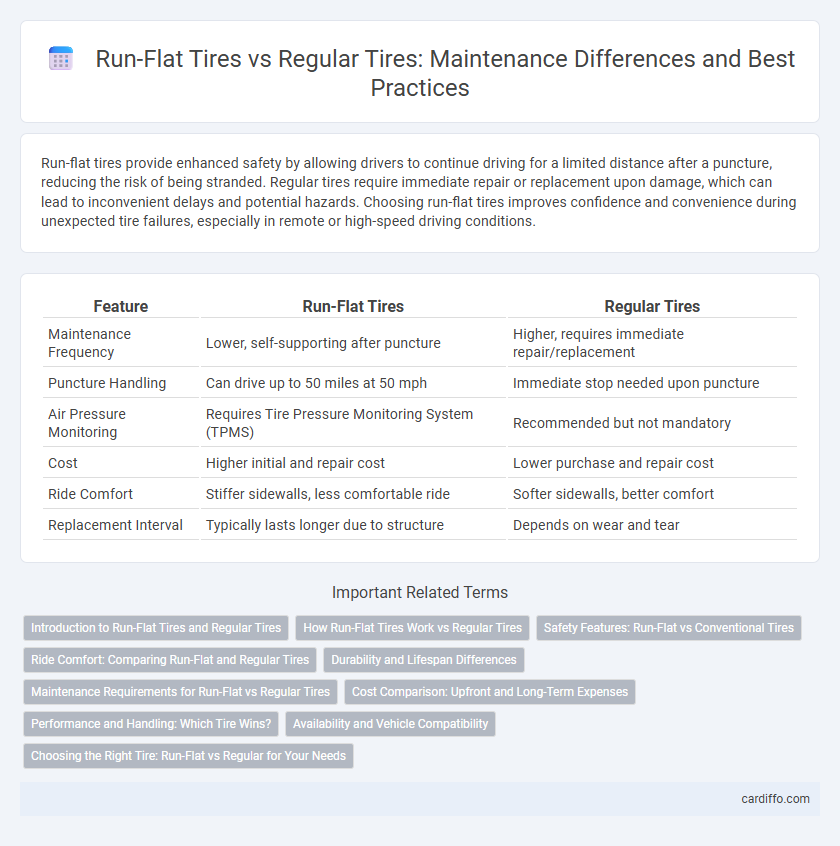Run-flat tires provide enhanced safety by allowing drivers to continue driving for a limited distance after a puncture, reducing the risk of being stranded. Regular tires require immediate repair or replacement upon damage, which can lead to inconvenient delays and potential hazards. Choosing run-flat tires improves confidence and convenience during unexpected tire failures, especially in remote or high-speed driving conditions.
Table of Comparison
| Feature | Run-Flat Tires | Regular Tires |
|---|---|---|
| Maintenance Frequency | Lower, self-supporting after puncture | Higher, requires immediate repair/replacement |
| Puncture Handling | Can drive up to 50 miles at 50 mph | Immediate stop needed upon puncture |
| Air Pressure Monitoring | Requires Tire Pressure Monitoring System (TPMS) | Recommended but not mandatory |
| Cost | Higher initial and repair cost | Lower purchase and repair cost |
| Ride Comfort | Stiffer sidewalls, less comfortable ride | Softer sidewalls, better comfort |
| Replacement Interval | Typically lasts longer due to structure | Depends on wear and tear |
Introduction to Run-Flat Tires and Regular Tires
Run-flat tires feature reinforced sidewalls that support the vehicle's weight for limited distances after a puncture, enhancing safety and convenience by eliminating the immediate need for tire changes. Regular tires rely on air pressure for structural integrity, requiring prompt repair or replacement when punctured to prevent vehicle damage. Understanding these fundamental differences is essential for effective tire maintenance and ensuring optimal vehicle performance.
How Run-Flat Tires Work vs Regular Tires
Run-flat tires are designed with reinforced sidewalls that support the vehicle's weight even when air pressure is lost, allowing continued driving for up to 50 miles at reduced speeds. Regular tires rely entirely on air pressure to maintain shape and support, causing immediate loss of control or damage when punctured. The structural difference in run-flat tires provides enhanced safety and convenience by enabling temporary mobility without immediate tire replacement.
Safety Features: Run-Flat vs Conventional Tires
Run-flat tires provide enhanced safety by allowing vehicles to continue driving for up to 50 miles at reduced speeds after a puncture, reducing the risk of being stranded in unsafe locations. Conventional tires require immediate replacement or repair after air loss, increasing exposure to roadside hazards. The reinforced sidewalls of run-flat tires maintain vehicle control and stability, improving safety during emergency situations compared to regular tires.
Ride Comfort: Comparing Run-Flat and Regular Tires
Run-flat tires typically exhibit stiffer sidewalls designed to support vehicle weight during air loss, which can result in a firmer ride and reduced comfort compared to regular tires with more flexible sidewalls. Regular tires generally provide better shock absorption and smoother handling on uneven surfaces, enhancing overall ride comfort. Vehicle owners prioritizing comfort often prefer regular tires, while run-flat options are favored for safety and convenience during a tire puncture.
Durability and Lifespan Differences
Run-flat tires feature reinforced sidewalls that maintain vehicle support during a puncture, significantly enhancing durability compared to regular tires. While regular tires typically offer a longer overall lifespan due to their flexible design, run-flat tires provide increased safety and convenience by allowing temporary continued driving after damage. The increased durability of run-flat tires often comes with higher wear rates, making their effective lifespan shorter than conventional tires under normal use conditions.
Maintenance Requirements for Run-Flat vs Regular Tires
Run-flat tires require less frequent tire changes after punctures, reducing the need for immediate roadside maintenance compared to regular tires that must be replaced or repaired promptly. Run-flat technology includes reinforced sidewalls, which demand specific tire pressure monitoring systems (TPMS) to prevent performance degradation, whereas regular tires require routine pressure checks and rotations for longevity. Maintenance costs for run-flat tires can be higher due to limited repairability and specialized equipment, while regular tires allow more straightforward and cost-effective maintenance procedures.
Cost Comparison: Upfront and Long-Term Expenses
Run-flat tires typically have a higher upfront cost, often ranging from 20% to 50% more than regular tires, reflecting advanced sidewall technology designed to support the vehicle during a puncture. Long-term expenses can be mixed; while run-flat tires reduce costs related to roadside assistance and emergency tire changes, their shorter tread life and higher replacement prices may increase overall maintenance costs. Regular tires generally offer lower initial investment and longer tread life, but additional costs might arise from emergency repairs or the need for carrying a spare tire.
Performance and Handling: Which Tire Wins?
Run-flat tires provide enhanced safety by allowing continued driving after a puncture, but they often sacrifice ride comfort and handling precision compared to regular tires, which typically deliver superior grip and responsiveness. Regular tires offer better performance in terms of cornering stability and braking distances due to their flexible sidewalls and lighter weight. For drivers prioritizing optimal handling and driving dynamics, regular tires generally outperform run-flat options under normal conditions.
Availability and Vehicle Compatibility
Run-flat tires are available in select sizes and are primarily compatible with modern vehicles equipped with Tire Pressure Monitoring Systems (TPMS) and reinforced wheel assemblies. Regular tires offer broader availability across diverse sizes, models, and vehicle types, making them suitable for most cars, trucks, and SUVs without specialized equipment. Vehicle compatibility for run-flat tires is often limited to OEM recommendations, while regular tires provide greater flexibility for aftermarket replacements and maintenance.
Choosing the Right Tire: Run-Flat vs Regular for Your Needs
Run-flat tires provide enhanced safety by allowing continued driving after a puncture, reducing the risk of being stranded, while regular tires offer better ride comfort and lower cost. Consider your driving habits, vehicle compatibility, and maintenance preferences when choosing between run-flat and regular tires. Prioritize tire pressure monitoring systems and availability of roadside assistance to ensure optimal performance and safety.
Run-Flat Tires vs Regular Tires Infographic

 cardiffo.com
cardiffo.com